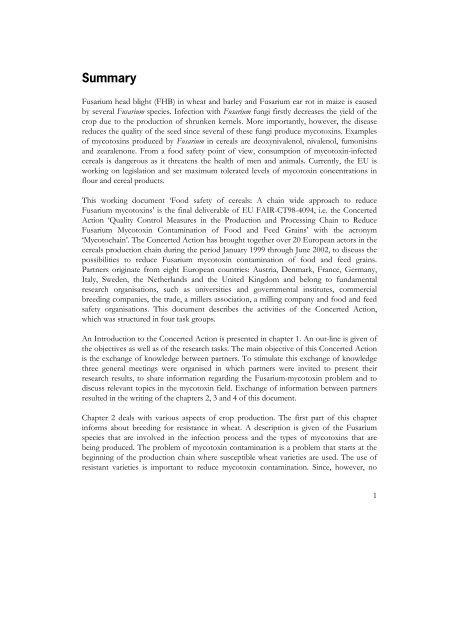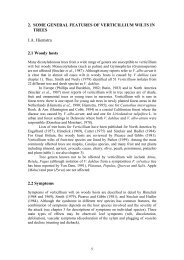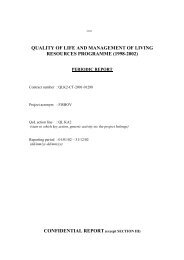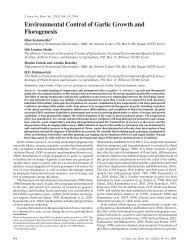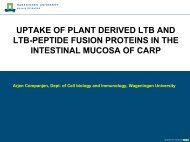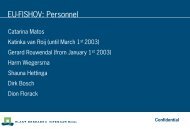3. Fusarium mycotoxins in cereals - Plant Research International ...
3. Fusarium mycotoxins in cereals - Plant Research International ...
3. Fusarium mycotoxins in cereals - Plant Research International ...
You also want an ePaper? Increase the reach of your titles
YUMPU automatically turns print PDFs into web optimized ePapers that Google loves.
Summary<br />
<strong>Fusarium</strong> head blight (FHB) <strong>in</strong> wheat and barley and <strong>Fusarium</strong> ear rot <strong>in</strong> maize is caused<br />
by several <strong>Fusarium</strong> species. Infection with <strong>Fusarium</strong> fungi firstly decreases the yield of the<br />
crop due to the production of shrunken kernels. More importantly, however, the disease<br />
reduces the quality of the seed s<strong>in</strong>ce several of these fungi produce <strong>mycotox<strong>in</strong>s</strong>. Examples<br />
of <strong>mycotox<strong>in</strong>s</strong> produced by <strong>Fusarium</strong> <strong>in</strong> <strong>cereals</strong> are deoxynivalenol, nivalenol, fumonis<strong>in</strong>s<br />
and zearalenone. From a food safety po<strong>in</strong>t of view, consumption of mycotox<strong>in</strong>-<strong>in</strong>fected<br />
<strong>cereals</strong> is dangerous as it threatens the health of men and animals. Currently, the EU is<br />
work<strong>in</strong>g on legislation and set maximum tolerated levels of mycotox<strong>in</strong> concentrations <strong>in</strong><br />
flour and cereal products.<br />
This work<strong>in</strong>g document ‘Food safety of <strong>cereals</strong>: A cha<strong>in</strong> wide approach to reduce<br />
<strong>Fusarium</strong> <strong>mycotox<strong>in</strong>s</strong>’ is the f<strong>in</strong>al deliverable of EU FAIR-CT98-4094, i.e. the Concerted<br />
Action ‘Quality Control Measures <strong>in</strong> the Production and Process<strong>in</strong>g Cha<strong>in</strong> to Reduce<br />
<strong>Fusarium</strong> Mycotox<strong>in</strong> Contam<strong>in</strong>ation of Food and Feed Gra<strong>in</strong>s’ with the acronym<br />
‘Mycotocha<strong>in</strong>’. The Concerted Action has brought together over 20 European actors <strong>in</strong> the<br />
<strong>cereals</strong> production cha<strong>in</strong> dur<strong>in</strong>g the period January 1999 through June 2002, to discuss the<br />
possibilities to reduce <strong>Fusarium</strong> mycotox<strong>in</strong> contam<strong>in</strong>ation of food and feed gra<strong>in</strong>s.<br />
Partners orig<strong>in</strong>ate from eight European countries: Austria, Denmark, France, Germany,<br />
Italy, Sweden, the Netherlands and the United K<strong>in</strong>gdom and belong to fundamental<br />
research organisations, such as universities and governmental <strong>in</strong>stitutes, commercial<br />
breed<strong>in</strong>g companies, the trade, a millers association, a mill<strong>in</strong>g company and food and feed<br />
safety organisations. This document describes the activities of the Concerted Action,<br />
which was structured <strong>in</strong> four task groups.<br />
An Introduction to the Concerted Action is presented <strong>in</strong> chapter 1. An out-l<strong>in</strong>e is given of<br />
the objectives as well as of the research tasks. The ma<strong>in</strong> objective of this Concerted Action<br />
is the exchange of knowledge between partners. To stimulate this exchange of knowledge<br />
three general meet<strong>in</strong>gs were organised <strong>in</strong> which partners were <strong>in</strong>vited to present their<br />
research results, to share <strong>in</strong>formation regard<strong>in</strong>g the <strong>Fusarium</strong>-mycotox<strong>in</strong> problem and to<br />
discuss relevant topics <strong>in</strong> the mycotox<strong>in</strong> field. Exchange of <strong>in</strong>formation between partners<br />
resulted <strong>in</strong> the writ<strong>in</strong>g of the chapters 2, 3 and 4 of this document.<br />
Chapter 2 deals with various aspects of crop production. The first part of this chapter<br />
<strong>in</strong>forms about breed<strong>in</strong>g for resistance <strong>in</strong> wheat. A description is given of the <strong>Fusarium</strong><br />
species that are <strong>in</strong>volved <strong>in</strong> the <strong>in</strong>fection process and the types of <strong>mycotox<strong>in</strong>s</strong> that are<br />
be<strong>in</strong>g produced. The problem of mycotox<strong>in</strong> contam<strong>in</strong>ation is a problem that starts at the<br />
beg<strong>in</strong>n<strong>in</strong>g of the production cha<strong>in</strong> where susceptible wheat varieties are used. The use of<br />
resistant varieties is important to reduce mycotox<strong>in</strong> contam<strong>in</strong>ation. S<strong>in</strong>ce, however, no<br />
1


